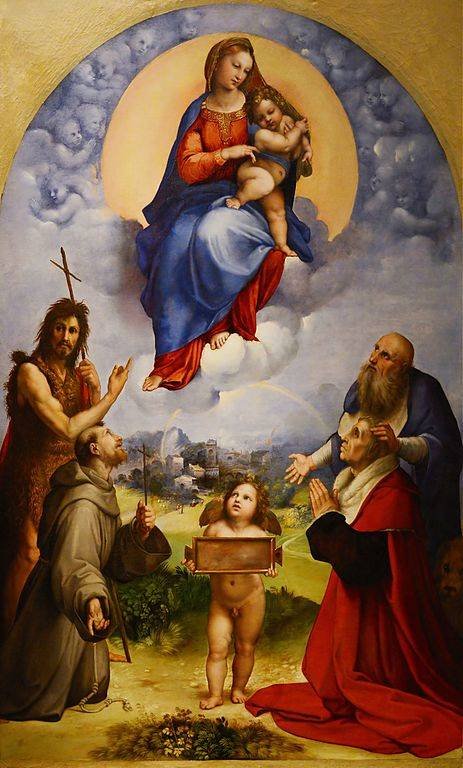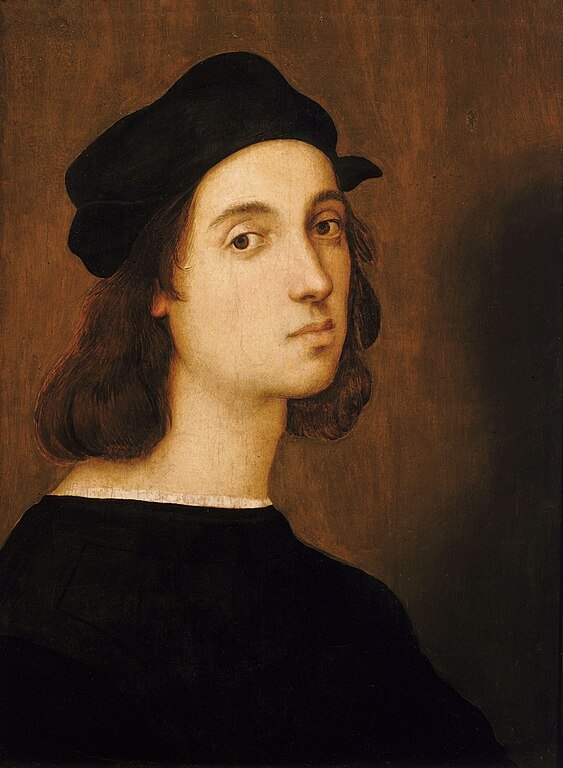Raphael’s The Madonna of Foligno is a magnificent example of High Renaissance art, showcasing the artist’s exceptional ability to harmonize divine and earthly elements.
Painted around 1512, this devotional masterpiece was commissioned by Sigismondo de’ Conti, a papal secretary, to commemorate a miraculous event.
With its vibrant colors, dynamic composition, and spiritual depth, The Madonna of Foligno exemplifies Raphael’s skill in creating works that inspire both awe and devotion.
About the Painting The Madonna of Foligno

The Madonna of Foligno was originally created as an altarpiece for the church of Santa Maria in Aracoeli in Rome. It was commissioned by Sigismondo de’ Conti to honor the Virgin Mary after a meteorite struck near his home in Foligno without causing harm—a miraculous event believed to be attributed to Mary’s intercession. The painting was later moved to the Vatican Museums, where it remains a centerpiece of the Pinacoteca.
The composition of The Madonna of Foligno is centered around the Virgin Mary, who is depicted seated on a cloud, holding the Christ Child. They are surrounded by a celestial glow, emphasizing their divine nature. Below, saints and angels form a semicircle, creating a connection between heaven and earth. Saint Jerome, Saint Francis of Assisi, and John the Baptist are positioned alongside Sigismondo de’ Conti, who is depicted in a posture of prayer and devotion. An angel at the center points toward the heavens, bridging the spiritual and earthly realms.
Raphael’s masterful use of color and light enhances the ethereal quality of the painting. The soft, glowing hues of the celestial realm contrast with the more subdued tones of the earthly figures, creating a visual balance that mirrors the spiritual harmony of the scene. The landscape in the background, with its meticulous attention to detail, adds depth to the composition and situates the miraculous event in a tangible, earthly setting.
The Madonna of Foligno also demonstrates Raphael’s exceptional ability to convey emotion through the gestures and expressions of his figures. The serene gaze of the Virgin, the tender interaction between her and the Christ Child, and the humble devotion of Sigismondo de’ Conti invite viewers to meditate on the power of faith and divine intervention. The dynamic arrangement of the figures creates a sense of movement, drawing the viewer’s eye upward toward the radiant Virgin.
Madonna of Foligno History and Significance
The Madonna of Foligno reflects the Renaissance ideals of beauty, balance, and spirituality. Its creation was deeply rooted in the personal devotion of Sigismondo de’ Conti, whose miraculous experience inspired this masterpiece.
The painting’s relocation to the Vatican ensured its preservation and prominence within the art world. As one of Raphael’s major works, it exemplifies his ability to blend artistic innovation with profound religious themes, solidifying his status as one of the greatest painters of all time.
About Raphael Sanzio

Raphael Sanzio (1483–1520) was one of the most celebrated artists of the Renaissance, renowned for his harmonious compositions, lifelike figures, and innovative use of perspective. Born in Urbino, Raphael was deeply influenced by the artistic traditions of his time, studying under Pietro Perugino and later drawing inspiration from masters such as Leonardo da Vinci and Michelangelo.
During his career in Rome, Raphael gained immense recognition, completing major works for the Vatican and private patrons. His untimely death at the age of 37 left the art world mourning the loss of a genius whose works continue to inspire generations.
Where to See It
Today, The Madonna of Foligno is displayed in the Pinacoteca Vaticana, part of the Vatican Museums. Visitors can admire its intricate details and luminous colors, which have been carefully preserved over centuries. Positioned alongside other masterpieces by Raphael, the painting offers a glimpse into the spiritual and artistic brilliance of the High Renaissance.
Visitor Tips
To fully appreciate The Madonna of Foligno, take time to observe the interplay of light and color, as well as the emotional expressions of the figures.
Guided tours or audio guides can provide valuable insights into the historical and artistic context of the painting. The Madonna of Foligno is a must-see for anyone exploring the Vatican Museums, offering a captivating encounter with one of Raphael’s most moving works.
More to Discover at Vatican Museums:
- The Magnificent Stefaneschi Triptych by Giotto
- The Divine Transfiguration by Raphael
- The Graceful Madonna of Foligno by Raphael
